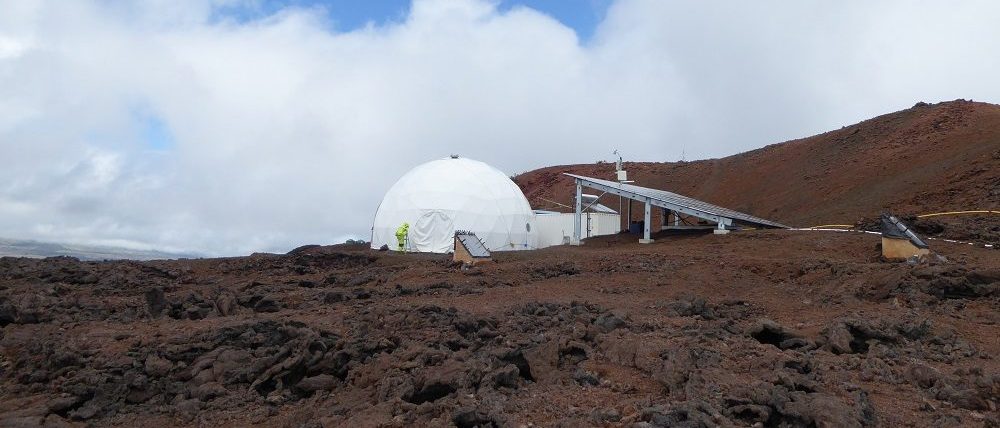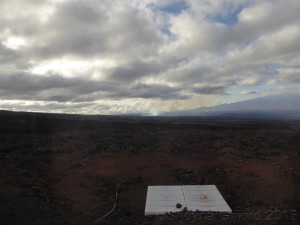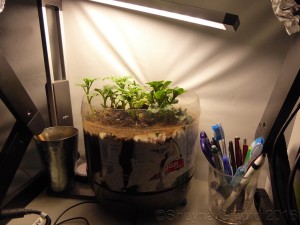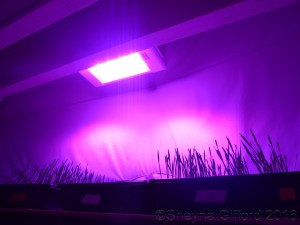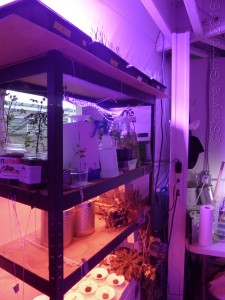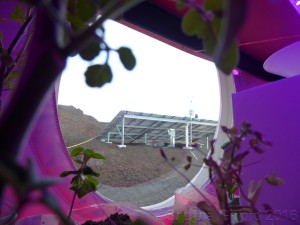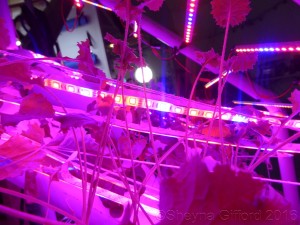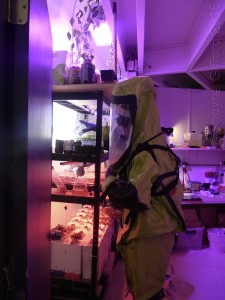Spring has come at last to simulated Mars. You might be asking: what does that mean? Are the snows melting? Are soft green blades breaking through the bare, furrowed ground? Are flowers blooming and birds returning from their winter abodes somewhere on the other side of the equator?
Well – notsomuch. In a place where nothing grows from the ground outside, spring doesn’t herald change the ways that it does on, say, a planet with a powerful magnetic field, a thick atmosphere, large oceans, and abundant animal life. You know, all the comforts of home. Still, we Martians have a good reason to celebrate the change of seasons. Springtime on the fourth planet from the Sun has one important thing in common with the same time of year in the Northern hemisphere on the third planet: longer days and shorter nights. Martians may not have April showers and cherry blossoms, but we do get to soak up a few extra minutes of sunlight every day.
Light means a lot to us – both in space and on Earth. It powers almost all the organic life we’ve ever encountered (geothermal powers the remainder, with a few weird iron-eaters thrown in for good measure). Free of charge, the Sun beams its energy to plants in packets called photons. On the front end, plants store those photons in the form of electron-packed carbohydrates and starches, which we think of as food. On the back end, animals who munch on those plants churn out much-needed fertilizer, fueling things that grow. It’s the ultimate in recycling, and it all begins with the huge nuclear fireball that holds our Solar System together.
Energy packets take a few more minutes to get to Mars (depending on where Mars is in its orbit) than they do to get to reach our planet. As on Earth, when those packets finally arrive, they are welcomed by the energy-dependent creatures that dwell there. As far as we know, Martian life these days is purely mechanical. The majority of rovers, landers, and satellites we’ve sent to Mars run entirely on solar energy (just one, Curiosity, uses atomic power). One day, cellular-based lifeforms like us will join them in rejoicing at the radiance.
To be fair, somewhere below the surface, life may well already be rocking on with its bad self. Also to be fair, as much as we’ll be relying on the Sun once we get there, we’ll also be cowering in the face of its unrelenting glare (but that is another story and will be told at another time). In any case, regardless of the cost, one thing you can say about humanity is: no matter our race, religion, or nationality, no matter where we are in the Universe, we sure do like our power.
Nowhere on Earth is immune from our love-affair with moving electrons from point A to point B. Whether we are cornered in a dark, watchful forest of Appalachia, camped out on a vast expanse of starlit desert in the Sahara, or clinging to a forbidding granite peak in the highest part of the Himalayas matters not a jot. Daily, the world over, we casually flick switches, ease on LEDs, and kindle fires. Pretty much all the energy we shuffle around, whether we’re burning logs to stay alive or turning it on with a button, had its origin in the Sun.* More Sun means more power, providing that you can capture those energy packets and lock them down until they are needed.
Plants do this with perfect aplomb. Like avid sunbathers, they turn their faces eagerly towards the photons falling on their unfurled surfaces. As luck (aka evolution) would have it, their faces are equipped with photon-trapping technology. To a certain extent, so is your face, which is why we tan. In addition to changing color, we also start the process of making Vitamin D from sunlight and cholesterol. Neat trick! Though, not quite the same as storing pure energy away for a rainy day.
What else has specially-designed photon-trapping technology? Solar panels! In a certain sense, solar panels are like large plants. Only, instead of storing energy in starches, solar panels pass them on to power systems for immediate use or storage.
At HI-SEAS, our power system is a modestly-sized array of solar panels, facing towards the top of Mauna Loa. As with plants, how much power it can produce for the crew depends on how much sunlight reaches its surface. How much sun is available, of course, depends upon the season (and the weather, which is driven by the season). Hooray for spring! Spring means more sun to light our days, and more energy falling on our 10 kW solar array.
10 kW – that’ s not quite as easy to understand as a 9-volt battery or 100-watt light bulb, is it? Let’s start with what a watt is and work our way up from there.
One watt is a little bit of power produced by an electric current. The current, moving like a tiny stream of electrons, is a lot like a river running downhill. Let’s call that river the ampere, or amp for short. The amp flows with a certain force. We call that force a “volt”. That’s right: a volt is actually a measure of electrical force. The same way that your weight is a measure of the force of gravity acting on your mass, pulling you towards the center of the Earth, volts are a measure of how much force is being placed on electric current, pushing it towards its destination. Now you may understand why the underside of your computer lists both a voltage and a current. Just like a specific volume of water needed to rotate a water wheel ten times, an exact amount of power (in amps) is required to flow to a device with a certain amount of force (in volts) for that device to work properly.
So, if we have volts and amps, why do we need watts? Well, for any force to act, it needs something to act on (you or a rock or an electron) and some amount of time in which to flex its muscle. The water wheel needs to turn over some amount of time (one second, one hour) for a certain distance (1 rotation or 101). You need to be in Earth’s gravity well for some amount of time to register as having a weight. A current of electrons (amps) with a force (volts) needs to push over a distance in a certain amount of time to light up a bulb (watts). A 100-watt bulb in an American outlet needs nearly one amp of current pushed through it every second in order to glow. When the sun is right overhead, our array of solar panels can capture and pass on enough of the Sun’s energy to light up a hundred 100-watt light bulbs: 10 kW.
Fortunately, unlike Las Vegas, we don’t need to light up nearly that many bulbs. As a bonus, the bulbs that we do have are high-efficiency. They need only 10 or 15 watts moving through them every second in order to shine brightly. The rest of the power is put to work keeping our yogurt and cheese cultures from spoiling, our frozen samples from melting, our indoor plants growing, our computers pushing bits back and forth, and our air circulating. That is, assuming that the sun is shining in the first place. During dim winter days from October until now, we often wouldn’t get enough power to turn on the heater. During those dark days, our poor plants would get only a few hours of LED time before we would have to shut their lights down, saving the few electrons we had for more critical systems. We, meanwhile, dawned heavy coats and downed tea by the liter.
These circumstance will no doubt befall Mars settlers, too, during big dust storms. Fortunately, such storms are rare. They take place every 2-3 years on Mars, or once an Earth-decade on average. When they do occur, they last only a matter of weeks. Wind speeds top out at 60 mph (97 kph). On Earth, that would be enough to bowl you over. On Mars, the atmosphere is 1% as thick as ours. That much wind MIGHT get a kite off the ground, if the kite were the size of a billboard and you had a running start. Mostly, the whole affair would just be dark and messy, like a planet-wide pillow-fight. A short-lived pillow fight, at that. As the puffy dust blocks out the Sun’s power, and storms soon run out of steam. Then, provided we had a back-up power source to see us through those few dark weeks, we would clean off the panels and begin again.
Here on Mars, we’ve made it through 7 months with less than a dozen days were we’ve needed to rely on backup power. When we did, that backup power ran for only a couple of hours before we went back to using stored solar energy. That’s pretty darn good, considering that we have 6 people, twice as many computers, dozens of plants and a full kitchen to support. The average US household pushes an average of 10,000 kilowatt-hours of energy per year through its walls, ceilings, and floors to run refrigerators, computers, dishwashers, and so on. That’s as much power as it takes to run a thousand 100-watt light bulbs for 100 hours; a little Las Vegas in every home in America.
People ask how we’re going to make it on Mars. Given how well the six of us manage with what we have – a single solar array and a tiny backup generator – I don’t see how we could miss. Every day on Earth we use, and misuse, many, many resources. Lob 1/100th of what we waste 100 million miles, land it safely on the surface of the planet next door, and a handful of people can survive on it quite happily. We’re living proof of that. So what stands in our way? Why haven’t we mustered the political will and technological might to ship over some panels plus everything else that’s needed, and prove the point? A question, I believe, is the roadblock. Answer this to everyone’s satisfaction and we’re on our way:
Assuming that we can ship over everything that’s needed for six people to make a go of it, what can Mars send us in return?
Based on current and past experience, I conjecture that a mission to Mars will turn around and power life on Earth in innumerable ways, just as space travel does today. Any time you get into a plane, hit the brakes in a car, or watch satellite TV, you’re harvesting the fruits of something we planted decades ago in order to make space safe, comfortable, or simple possible for humans. Millions of people across the world are walking thanks to space-technology-derived artificial limbs. Hundreds of people have been kept alive while awaiting transplants by NASA-supported heart-pumps.
Even if the world would be just fine without little things like enriched baby food, cordless vacuums, temper foam, and freeze-dried provisions, what we stand to gain in terms of knowledge about how to live in more extreme environments is going to come in handy. It already is. Every time we dial 911 and someone comes to fight a fire, they are loaded up with NASA-derived survival gear. Up here, we’re experimenting with bacteria that can clean air and water, because, no matter where humans go, we need both, badly. The ability to survive and thrive on very little isn’t just a matter of pride. It’s a matter of practicality. Give us some sunlight, a handful of Martian soil, a vial of microbes. We can make it work. We’re learning how to make it work.
We have the power.
* Less than 20% comes from nuclear reactors.
